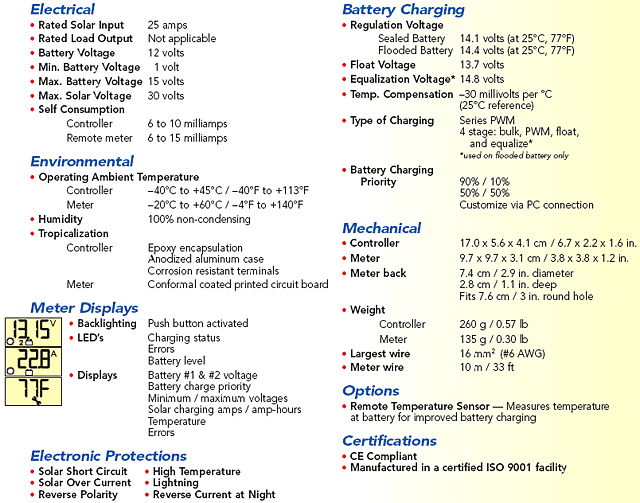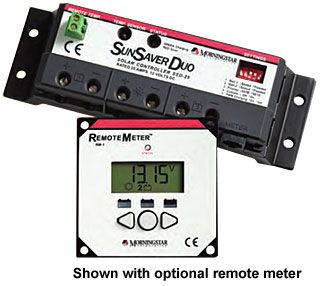

Morningstar’s SunSaver Duo is an advanced PWM two battery controller for remote solar charging applications.
The unique advantages of the Sunsaver Duo are:
• Two Battery Charging; one primary battery is fully charged, the excess solar power is routed to the second battery.
• Optional Back-lit Remote Meter
• Easy Installation
• Lower Cost
Morningstar’s SunSaver Duo is an advanced PWM two battery controller for many remote applications.
This product will charge two separate and isolated batteries at the same time, such as an engine battery, WiFi transmitter battery, remote solar system. This is based on user selectable priorities. The SunSaver Duo employs Morningstar’s legendary SunSaver controller technology, whose long-term track record for high reliability and improved battery charging is well-recognized in the solar industry. This controller also has the option of a backlit remote meter which may be mounted in or on a wall. This remote meter displays digital and pictorial status information about the solar power system. Most of our customers require this comprehensive remote meter.
The SunSaver Duo is epoxy encapsulated for environmental protection, is user adjustable via DIP switch or connection to a personal computer, and has an optional remote temperature sensor.
 Two Battery Charging
Two Battery Charging
Solar charge current is shared between the two batteries based on a user selectable priority. When one battery is fully charged, all of the charge current flows to the other battery.
Provides Useful Information
The remote meter and LED’s display system status data and any system errors. Custom icons and back lighting make the meter easy to read and understand.
Lower Cost
Two battery charging eliminates the added cost of two separate solar charging systems and the need for isolation between the batteries.
Easy to Install
The controller is installed near the batteries using the clearly labeled large wire terminals. The remote meter may be mounted in the wall or on the wall using the included frame. Also includes the meter wiring with RJ-11 connector.
Longer Battery Life
Four stage series PWM pulse charging and temperature compensation increases the useful life of the batteries.
Extensive Electronic Protections
The controller will not be damaged by wiring mistakes during installation. There are no fuses to replace, and the controller will automatically re-set after a wiring mistake.
Highly Reliable
Epoxy encapsulation protects the controller against dust and high humidity. Efficient electronics and a conservative thermal design allow the controller to operate reliably at high temperatures.
Dimensions: 6.7” x 2.2” x 1.6”. Units weigh .57 lbs. 5 year warranty, 15 year estimated life.

SunSaver Duo Uses PWM Technology
What is PWM?
Pulse Width Modulation (PWM) is the most effective means to achieve constant voltage battery charging by switching the solar system controller’s power devices. When in PWM regulation, the current from the solar array tapers according to the battery’s condition and recharging needs.
Why is there so much excitement about PWM?
Charging a battery with a solar system is a unique and difficult challenge. In the "old days", simple on-off regulators were used to limit battery outgassing when a solar panel produced excess energy. However, as solar systems matured it became clear how much these simple devices interfered with the charging process.
The history for on-off regulators has been early battery failures, increasing load disconnects, and growing user dissatisfaction. PWM has recently surfaced as the first significant advance in solar battery charging.
PWM solar chargers use technology similar to other modern high quality battery chargers. When a battery voltage reaches the regulation setpoint, the PWM algorithm slowly reduces the charging current to avoid heating and gassing of the battery, yet the charging continues to return the maximum amount of energy to the battery in the shortest time. The result is a higher charging efficiency, rapid recharging, and a healthy battery at full capacity.
In addition, this new method of solar battery charging promises some very interesting and unique benefits from the PWM pulsing. These include:
1. Ability to recover lost battery capacity and desulfate a battery.
2. Dramatically increase the charge acceptance of the battery.
3. Maintain high average battery capacities (90% to 95%) compared to on-off regulated state-of-charge levels that are typically 55% to 60%.
4. Equalize drifting battery cells.
5. Reduce battery heating and gassing.
6. Automatically adjust for battery aging.
7. Self-regulate for voltage drops and temperature effects in solar systems.
How does this technology help me?
The benefits noted above are technology driven. The more important question is how the PWM technology benefits the solar system user. Jumping from a 1970’s technology into the new millennium offers:
• Longer battery life:
• reducing the costs of the solar system
• reducing battery disposal problems
• More battery reserve capacity:
• increasing the reliability of the solar system
• reducing load disconnects
• opportunity to reduce battery size to lower the system cost
• Greater use of the solar array energy:
• get 20% to 30% more energy from your solar panels for charging
• stop wasting the solar energy when the battery is only 50% charged
• opportunity to reduce the size of the solar array to save costs
• Greater user satisfaction:
• get more power when you need it for less money!!
Are all of these benefits tested and proven?
A great deal of testing and data supports the benefits of PWM. More information is attached that describes the technology and various studies. Morningstar will continue our ongoing test programs to refine the PWM charging technology. Over time, each of these benefits will be improved and more clearly defined with numbers and graphs.
Are all PWM chargers the same?
Buyer beware! Many solar charge controllers that simply switch FETs differently than the on-off algorithm claim to be a PWM charger. Only a few controllers are actually using a Pulse Width Modulated (PWM) constant voltage charging algorithm. The rest are switching FETs with various algorithms that are cheaper and less effective. Morningstar was awarded a patent in 1997 for a highly effective battery charging algorithm based on true PWM switching and constant voltage charging. All Morningstar products use this patented algorithm.
Call toll-free (877) 297-0014 for complete systems and Morningstar SunSaver charge controller wholesale pricing.

